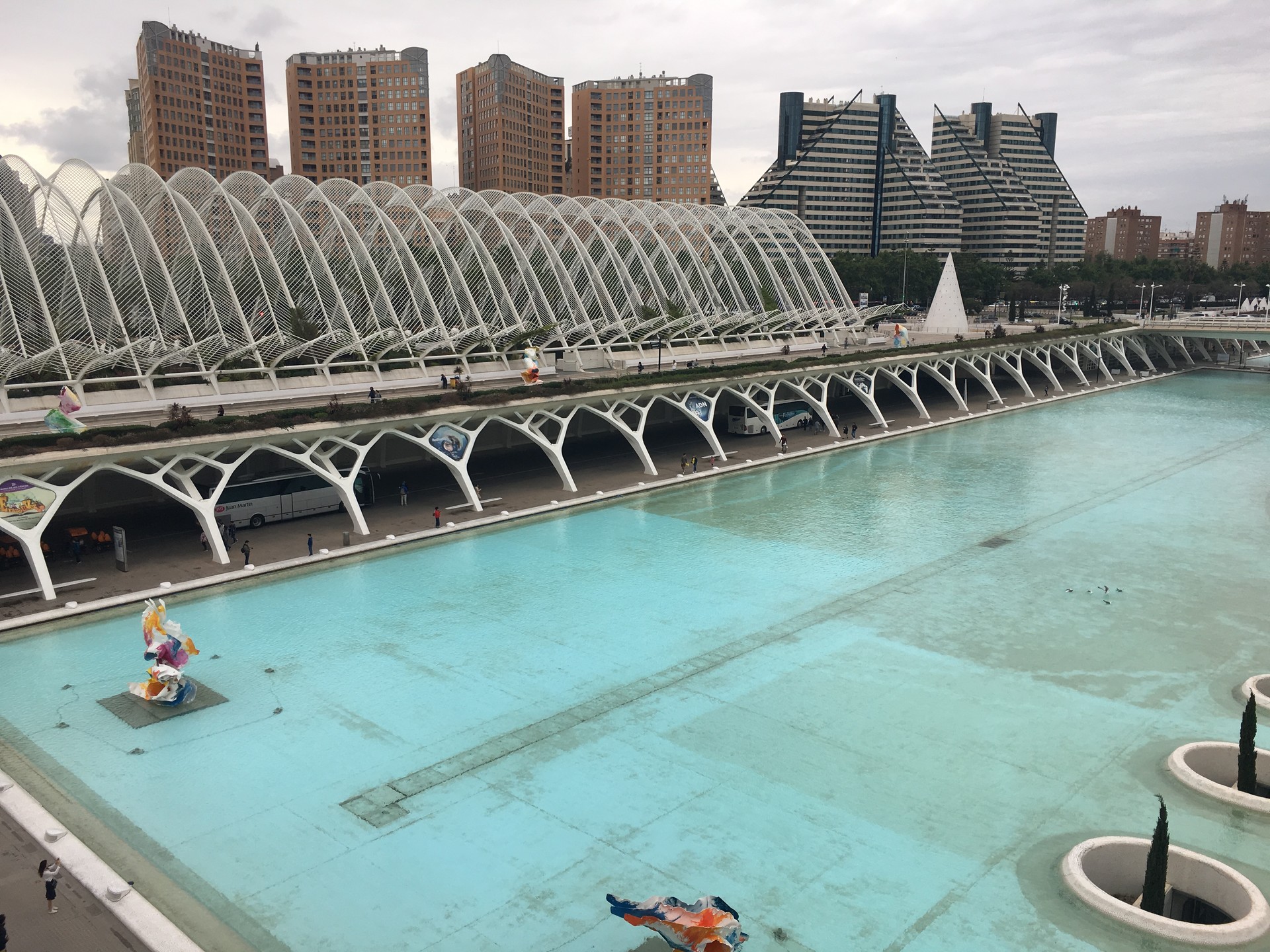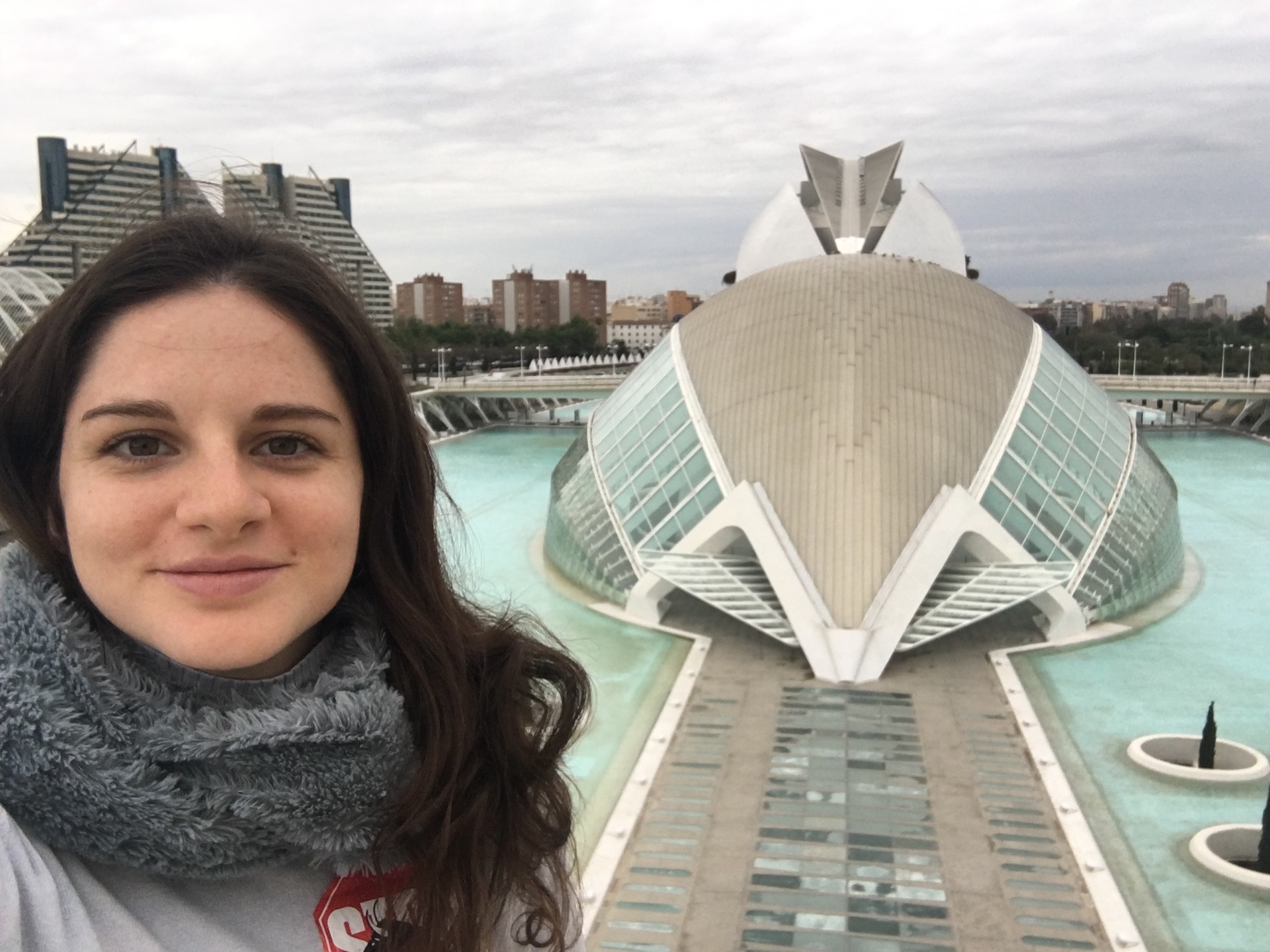Living in Valencia
I have been living in Valencia for a year so now I think I can tell you what the city's like. This city isn't very big, nor is it too small, and you can get to almost everywhere by bike. Although you can also take the metro, bus and tram to get around.
One of the most touristic places, and the reason why Valencia is so famous, is the City of Arts and Sciences, which unfortunately you can't get to by metro, but by bus. It's an incredible place, made up of 4 parts:
- The Science Museum, which is the most well-known and is the biggest building in the complex. This museum consists of three floors, although the second floor is only used to connect the first floor to the third floor. There are many interactive activities in this museum, for children to take part in, so no one misses out on learning. This museum also has various pools outside with different activities you can do there. In one of them, there are giant balls you can get inside and start to run around like a hamster. Most people end up falling over very quickly, but it's so fun for kids as well as for adults. Other activities you can do in the pools, in the ones which are no longer only there for decoration and are now being used, include kayaking and paddle boarding (where you stand on a surfboard and sail around by using a paddle to glide through the water). The kayaks you can hire are the typical transparent ones which I think is incredible. In addition, in this part of the museum there's a room for special events. For example, the current event they're holding is on Harry Potter. On the other side, there's the Opera theatre, which you can get your tickets for in advance.

- The Hemisphere is where you can go to watch films in 8D. You have to buy a ticket to go in, but you can walk around the outside of it for free. It's completely surrounded by water, and you can only get to it via the one path which floats on the water.

- The Agora, which was finished being built a little while ago. Its current use is only for special events. According to what the actual architect of the Science Museum in Open House had said, they're shortly going to build another building inside the agora, which will be open to the public, but they haven't started the project yet.
- The Oceanographic, an incredible place full of waters and thousands of aquatic animals as well as birds. Its buildings also have a unique architecture and it's what characterises it and makes it part of the City of Arts and Sciences complex.
As well as this famous tourist place in Valencia, the next best thing would be the historic centre, which is all around 50% of the river (now it isn't a river because a few years ago it caused a fire which led to the authorities making a decision to remove all the water and leave it as a natural green area). The historic centre is made up of many small streets, excluding the town hall street which goes towards the town hall (a free place I recommend visiting) and to the town hall square. In this historic centre you can find the Cathedral of Valencia and many churches of great interest. The area called "Barrio del Carmen" is a place where lots of people get together at night to drink and eat as it's a very beautiful place to spend the night, with all the lights. In addition, in the centre there are many tourist bars and restaurants. Another attraction is the Central Market, where they sell lots of fruit and vegetables as well as meat and fish. In the outskirts of the historic centre you can find the Serranos Towers, where the opening of the festival called "las Fallas" takes place. It's a typical celebration in Valencia and you can't miss out on it. There are also museums to visit, such as the ceramics museum and the HQ of the Valencia government.
In the so-called "river" there's a lot of nature thanks to the inhabitants of Valencia claiming that they wanted the river to be converted into a natural space and not a motorway as officials had wanted. Nowadays the river goes through all the attractions, such as the City of Arts and Sciences and the Palau de la Musica. . There are also football pitches, water sources, games for children and places to spend the evening surrounded by nature.
Another famous tourist attraction in Valencia is obviously the beach, which is a few kilometres long. The beach is luckily really big, and in spring and summer lots of people go there. It has freshwater showers, a wooden path going towards the beach for disabled people or for buggies, and public baths which normally have a long queue to enter. In addition, along the whole seafront there are many restaurants to choose from and I remember there being places to buy souvenirs before leaving this pretty city. The majority of restaurants are on the seafront which is closest to the port, where at night and during sunset it's absolutely beautiful with all the lights. You can also walk along the port but it's nothing special, although during Christmas time, they always set up an amusement park which is open in December and January, with lots of games for children and adults, you have to pay of course. There are stalls where you can win cuddly toys and electronics if you play and win.
Further out from the port and the centre of Valencia, but still on the coast, you'll find Little Venice, an excellent place to take photos and a must-see if you go to Valencia. This place has lots of different coloured houses with a view of the port, and where the canals actually go between the houses. There are also very good places to eat there and the beach isn't as crowded as the one called "Cabanyal". Although Little Venice is a very touristic place, unfortunately there's no way of getting there by using public transport, so the only way to get there would be by car, bike or taxi. That's why I recommend buying yourself a bike if you are thinking of living in Valencia. That way you can get to anywhere in the city and it's the cheapest and healthiest way too.
For shopaholics, I must also say that there are many shopping centres in Valencia, although the biggest and most well-known isn't that near the centre, and it's called Centro Comercia Bonaire. Then there are other types of smaller shopping centres which are good, such as "El Saler" and "Aqua", which are located around the City of Arts and Sciences. Another one called "Nuevo" is above the historic centre. There is also a street called "calle Colón" which separates the historic centre from the Ruzafa district. It's full of clothes stores and electronic shops, and that's where you'll find "El Corte Inglés" (just like the one in the City of Arts and Sciences), Primark and "MediaMarkt". You can get to this street by taking the metro and getting off at the stop called Colón as well as the stop called Xátiva. Also, near the stop called Xátiva, you can see the bullring and the train station, which is extraordinary because of its unique facade.
Ruzafa is the prettiest district in all of Valencia, and that's why it's also the most expensive. That's where the nightlife is with all the bars and there are also clubs in the area. Normally the richer people come to this area to spend the night, and during the Fallas festival, it's where most of the statues are placed.
Now you know all there is to do in Valencia and all the places you need to visit in this beautiful city, I hope you make the right decision when choosing how many days you want to spend in Valencia to be able to see these places or the places you like the sound of most.
Photo gallery
Content available in other languages
- Español: Viviendo en Valencia
- Italiano: Vivendo a Valencia
Want to have your own Erasmus blog?
If you are experiencing living abroad, you're an avid traveller or want to promote the city where you live... create your own blog and share your adventures!
I want to create my Erasmus blog! →




















Comments (0 comments)